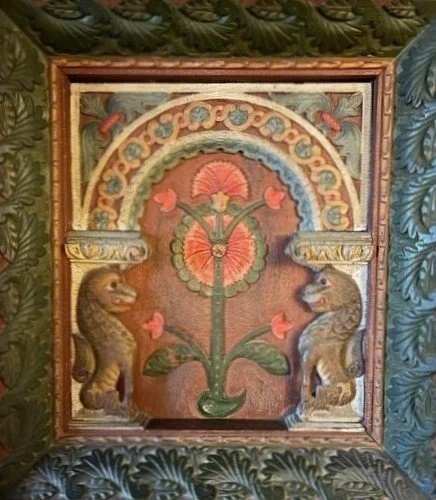A Long Winter's Nap
Winter is long. Naps are great. On average, humans spend about 33 years in bed so those who can afford it often devote a great deal of money and effort to ensuring that they have a comfortable place to sleep. Have you ever heard that Shakespeare left his “second best bed” to his wife? While it seems weird to us, this was a very generous inheritance! In early modern England, beds were custom made and, as a result, were ridiculously expensive —probably the most expensive piece of furniture one would own.
Beds helped to create a private, warm, space in an era with very little privacy. Many family members and servants shared the same sleeping space. To create privacy and trap warmth, curtains would be hung from the tester, a wooden canopy. The intricately carved and highly decorated dosser, or headboard, held up the tester on one end and two elaborately carved posts did that job at the foot of the bed. The foot posts were not physically attached to the bed stock, or base, of the bed. The bedding would lay on a foundation of ropes which were strung tightly across the bed stock. These ropes would be tightened as needed with a bed wench—the expression ‘sleep tight’ comes from the use of ropes on beds.
Beds became more comfortable as the centuries progressed. In the mid-sixteenth century, dressing a bed has many steps. Directly on top of the ropes was a woven rush mat or slim mattress. On top of that would be a feather mattress, followed by sheets, blankets, rugs, and quilts, with pillows and bolsters piled up at the headboard. The bed curtains would complete the bed dressing. This short video, put together by the Victoria and Albert Museum, further explains the steps to dressing a bed: https://youtu.be/xULpm9Q57mc
When looking at Elizabethan era beds, it is important to note that 16th and 17th century beds were shorter than the furniture pieces we use today. This was not because people were shorter, but rather because of the preferred sleeping position in that era. In those days, people slept in a half sitting position for a variety of reasons. For one, it is a great position to help with breathing and aid in digestion while asleep. Also people were a bit superstitious and felt that lying flat while asleep made one look like they were already dead or were inviting death to take them prematurely. Because most people slept this way, beds did not need extra length, and since the bottom half of the headboard was hidden by mattresses and pillows, there was no need to decorate that section.
Currently on display at Agecroft, we have two magnificent beds. While we will discuss the second bed in our February post, the first is a 1580s bed (above) with tester and cornice. Every visible surface of this bed is elaborately carved and decorated, indicating this piece must have been an expensive commission. The beautiful bed proudly displays its original paint of reds, blues, and greens—reminding us that people have always enjoyed color in their homes and, again, giving the bed a sense of grandeur that cost a lot of money.
This painted bed has all manner of decorations—carved architectural moldings such as guilloche, running leaf patterns, and strap work. There are carved dragons, terrifying angels with red hair, cherubs, and satyrs, each a symbol chosen to represent something important to the owner—many of these symbols have to do with fertility, which seems fitting for a bed. While our beds today are pretty tame in comparison, these decorative motifs are found on many Elizabethan beds, including the Great Bed of Ware, as seen in the above linked YouTube video. There is seemingly something new to discover about this bed every time one looks at it and it is fun to imagine waking up in this bed everyday—would it be terrifying or are all these carvings a welcome start to the day?
If we humans truly do spend over a third of our lives in bed, why not make that bed a fully customized and beautifully designed piece? Elizabethan beds were extremely expensive, but they were also grand, and sometimes fanciful, pieces that brought color and richness into bedrooms. Beds spoke to the wealth and status of its owner and were heirloom pieces that would be passed down through the generations. Come check out our painted bed while at Agecroft Hall for a tour, either before or after your long winter’s nap!









